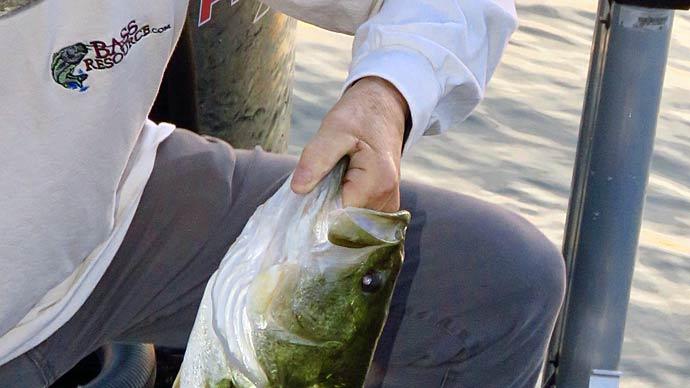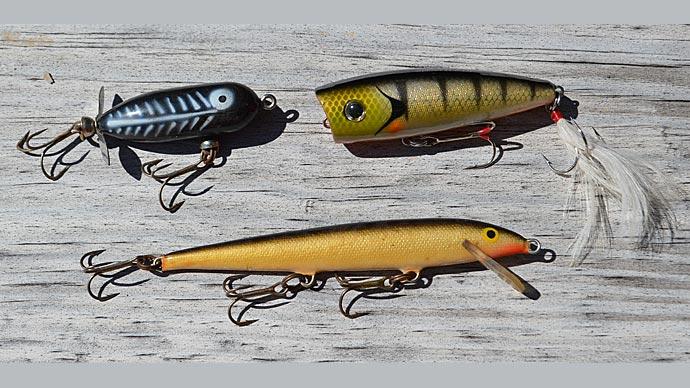
Overlooked and underrated, the buzzbait is my secret go-to lure for several conditions. Many anglers put the buzzbait to the side and use spinnerbaits or other topwater baits in their stead, but when used right, the buzzbait is deadly. It is easy to use and is very versatile bait.
The buzzbait is the only topwater wire bait, a jig head with a skirt and hook attached to a wire, which attaches to your line. The other end of the wire has a propeller on it. The propeller creates lift when spinning, keeping the bait on the surface.
Most buzzbaits have one propeller with two blades, but some come with two propellers, and some come with three blades on each propeller. In addition, some come with a "clacker," a metal triangle attached to the wire that ticks the propeller as it spins. This creates a loud clacking noise that attracts the bass' attention. One of the buzzbait's best things is that it is one of the few weedless topwater baits with a good hit-to-hook-up ratio.
The best way to fish the buzzbait is to toss it out and vary your retrieve until something works. Cover a body of water thoroughly where you suspect there are fish, casting 4-to 8 feet to the right of the cast before (or left, depending on which way you are going), and make each cast a little different. Generally, the bass will hit a slower retrieve sooner during the dog days of summer, but when the bass are hunting for food, faster retrieves can produce more strikes. Slowing down by structure and speeding up when you are past is a great technique. If the bass doesn't strike when it goes by, and they follow it out of the structure, speeding it up will make it look like it is running from the bass, triggering the bass' feeding instinct. (Make sure you are not burning it to the point where a bass can not catch up) This works best during the spring and fall.
The thing with buzzbaits (and with all lures) is some days, the bass will crush them, and other days they don't even seem to notice. If you are switching the retrieve around and fishing good structure and still don't get any hits after a couple of dozen casts, then it is probably one of the days when the bass ignore them. I always give this lure a go because, on certain days, the bass boil the water with furry, and you can land lunkers like there is nothing to it. If the bass are striking hard, they are more likely to hit a buzzbait, and when they are slower to hit, the bite may not be as good.
I have caught several large bass on the buzzbait, and my current personal best for largemouth was caught on a Booyah buzzbait. I like a ½-ounce, black, or chartreuse buzzbait with the clacker. Change your skirt color for different conditions, and always use black in stained water or at night.
I know a clacker feature makes all the difference. Strike King and Terminator make good buzzbaits, and if you prefer these, you can order the clackers in bulk from most component stores and install them yourself. Clackers make much more noise, calling aggressive bass from long distances. If the bass are timid, using a buzzbait without a clacker can be better, but I generally use one because bass are aggressive fish.
Triple-bladed propellers are superior in many aspects. They can run slower, make more noise, and add more weight to the lure (for longer casts) without making it sink. Sadly, no name-brand triple-bladed buzzbaits come with the clacker, so I like to buy a triple-bladed version and then add the clacker myself, or you can buy buzzbaits and add the clacker and triple blade. Just like spinnerbaits, buzzbaits can be easily modified. Also, like spinnerbaits, your lure will run crooked if the wire is bent. If your buzzbait runs to the right, bend the wire to the left, and vice versa.
The key to casting the buzzbait is all about timing. To get the bait to land quietly and run on the surface, thumb the spool (or close the bail) an instant before the buzzbait hits the water, then start the retrieve. When done correctly, the buzzbait will make a perfect landing and run on the surface for the entire retrieve. This takes a little practice and is easier with casting gear. For this reason, I prefer casting tackle for buzzbaits.
If you fish buzzbaits, often you will notice right away there are a lot of missed hits. The fast retrieve nature of this bait makes it harder for bass to hit. The bass missing the lure can't be helped, except by retrieving it slower. However, bass spitting the hook is a problem with all single-hook lures. There are a few ways to help keep the bass on the line; one is by attaching a good trailer hook. You can significantly improve your catch-to-hit rate by doing this, and these can be bought at basically any tackle shop.
A sharp hook is essential for good hooksets, even if you have a trailer hook. I sharpen my hooks every trip before I use them, and it helps with the hook set more than you can imagine. It is incredible what a hook hone that costs a few bucks can do. If you have old buzzbaits that have dull hooks, don't toss them. A few minutes with a hone can make them sharper than new.
A longer rod with a fast tip can also help keep pressure on the line, thus reducing spit hooks. But a good backbone is needed in the rod for the hook set, as with all single hook lures. Something around a 7-foot medium will do just fine.
When a bass hits your buzzbait, stop the retrieve, count to 3 Mississippi, then set the hook as hard as possible. When the bass hits the lure, setting the hook right away can pull the lure out of the mouth. For example, counting to three allows enough time for the bass to get it in its mouth for a proper set. This is the best way to reduce your misses when using this lure. Don't wait forever, though, because the bass will only hold onto a piece of metal for a short time.
If the bass misses the lure, cast a Senko where the hit took place. If that doesn't produce, run the buzzbait over the same place again.
As far as line goes, I use 10-pound mono, but heavier mono and braid will perform equally as far as buzzbaits go. Since the line is basically out of the water, the entire retrieve, line diameter, and visibility aren't as important, so feel free to use whatever you are comfortable with. Using heavier rods and braid will also help your hook sets.
One great thing about the buzzbait is that it is entirely snagless. Running a buzzbait through the brush, lily pads, weeds, sunken trees, or any structure is deadly. Casting under docks is the ideal place for hot summer days. Running over very shallow coves can be deadly during the spawn. Be bold and throw it into thick timber because 99% of the time, it comes out, and that is where the big bass are. If you are fishing heavy brush, use heavier mono or braid to haul them out before they tangle your line.
When a bass sees a buzzbait go by, they ignore the propeller. The bass sees a lot of splashing and commotion, and they see the jig with the skirt swimming under the surface. They most likely assume it is a school of baitfish, some other bass off its rocker, or an annoying thing that looks tasty. Regardless, they attack the skirt, and they do not attack the propeller. For this reason, the blade color on the buzzbait is not a factor as it is with other wire baits. Skirt color is much more critical than the propeller, so worry about that. You do not want the propeller to stand out.
The bottom line, the buzzbait is one of the most fun topwaters around. Nothing better than watching a big bass slam your buzzbait and blast it out of the water. As with all lures, some days they don't work, but others are the best lures to use. Switch your style around and see what works best. Keep your hooks sharp and count to three; it won't take long until you have landed some big bass.




